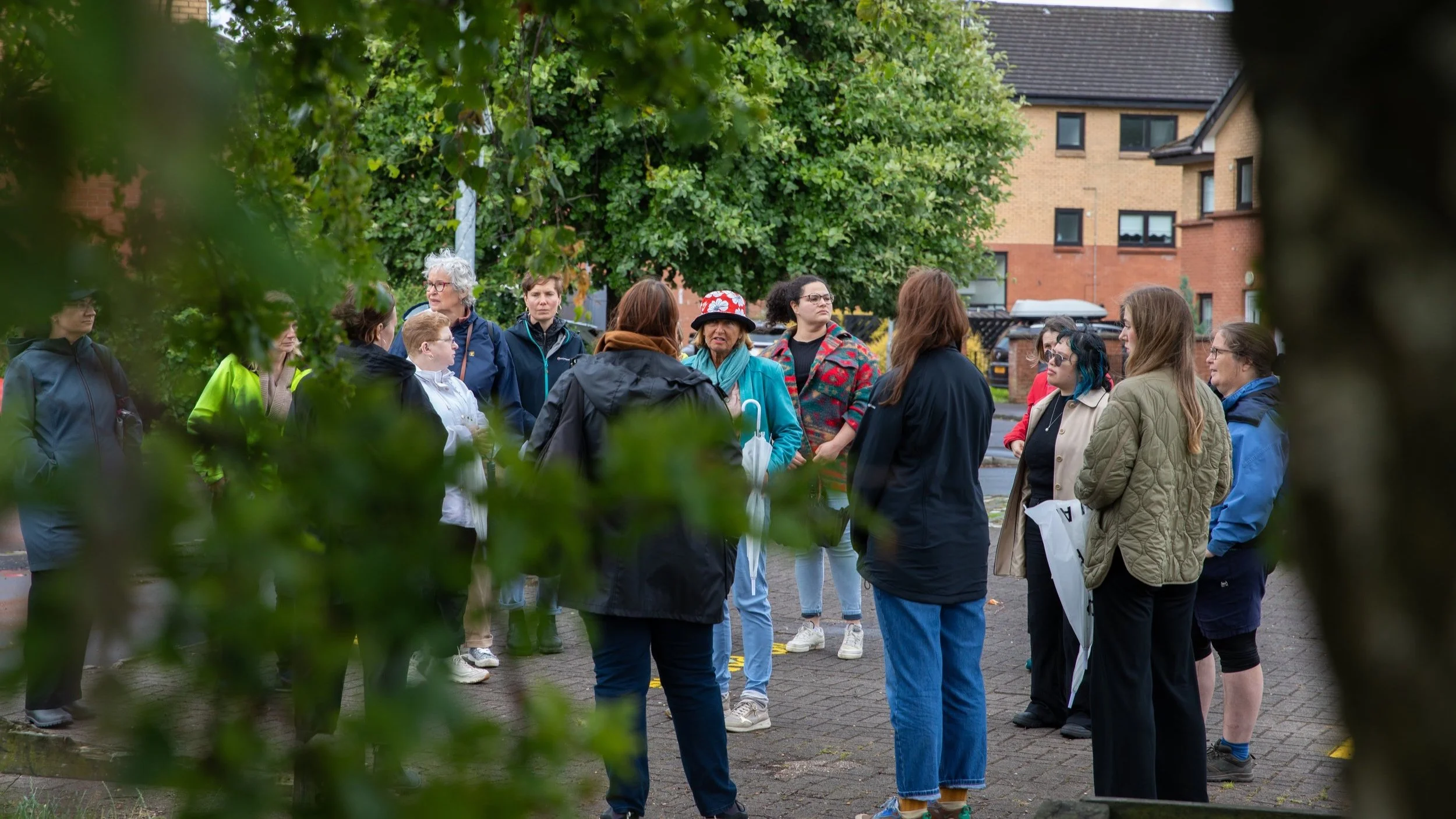Bridgeton Reimagined: A Community Walk for Change
The health of a community is proportional to the availability of places where people can get together such as the iconic Umbrella at Bridgeton
On a rainy late afternoon in Bridgeton, Glasgow, a group of women—members of the Glasgow Women’s Library (GWL) and the local community—zipped up coats, unfurled umbrellas, and set off on a purposeful walk. This wasn’t just any community stroll. It was part of GWL’s commitment to climate action and a net-zero future by 2030, focusing on how green spaces and active travel routes can serve everyone—especially through a gender-sensitive lens.
At the heart of the walk was the concept of regenerative observation—a method that encourages identifying and nurturing the unique strengths of a place. What emerged was a vivid, layered portrait of Bridgeton: a neighbourhood full of potential rooted in its multifaceted character.
Starting at the Glasgow Women’s Library Garden
Once a tarmac-covered forecourt, the Library’s front area is now a small oasis of green – raised beds, climbing vines, and reclaimed benches. It feels very different now – softer, greener, more alive. It proves that even tiny plots can grow food, cool pavement, and spark conversation. Though it’s only accessible when the Library is open, it represents a quiet but powerful example of how disused spaces can be reimagined as nurturing public places. Some saw the regenerative potential of this model replicated across the city in other overlooked corners: a new network of pocket-gardens to support wellbeing, food growing, and social connection.
Bridgeton Cross: Busy, Open and Lively
At the Cross, the group observed a unique street layout—open and flowing, unlike the rigid grids elsewhere in the city. The place feels safe and, full of movement and community. A popular fresh fruit and veg stall set up twice a week, adds to its vibrancy. Still, participants saw potential – especially under the large, iconic Umbrella. They suggested adding face-to-face seating with armrests for older users to foster comfort and interaction. Others proposed flexible furniture for pop-up events or performances, turning the Cross into a true civic square.
London Road to Olympia Street: Green, but Disconnected
Across London Road lies a patch of green space, dotted with trees but rarely used. It feels isolated—perhaps because of the busy road and the absence of seating. Could improved pedestrian crossings help better connect this area to the daily rhythms of Bridgeton Cross? The group also wondered whether signage, lighting, and clearer sightlines could draw more people in and make it feel safer and more visible. This space has potential—as a place to pause, play, or meet—but it needs better stitching into the surrounding urban fabric.
Group walkabouts are dynamically multisensory engaging multiple senses of participants - visual, sound, smell, social and cognitive processes.
Moving on: Smooth Pavements, Tricky Crossings
Walking toward Dalmarnock Road, the group appreciated the wide, smooth pavements—spacious and accessible. But frequent buses made crossing the road difficult and unsafe. Accessibility, they noted, goes beyond surface quality. What if raised or zebra crossings were added, signalling that pedestrians really matter here?
Heron Street: Quiet, but Car-Dominated
In the car park between residential blocks on Heron Street, the space felt quiet but dominated by vehicles. Women envisioned more seating and play spaces where children could be seen from nearby windows. Adding more dropped kerbs would also improve accessibility for those using wheels –prams, wheelchairs, or mobility aids. They also imagined greening the car park edges – planters, trees, or rain gardens – to soften the space, encourage more pedestrian use, and signal that this area belongs to people, not just cars.
Queen Mary Street: A Place for Play—with Room to Grow
Tucked off Queen Mary Street, a modest green space offered little beyond basic play gear and an unused bike hangar. The group imagined more – seating, skate ramps, features for teens. They saw a space for all ages to sit, socialise, and relax, free of charge.
The discussion grew: What if zoning supported everyday needs of the community? A walkable neighbourhood with fresh bread, milk, and essentials nearby. One participant highlighted the value of an affordable bakery. Could play spaces also host micro-economies – like kiosks, tool shares, or pop-up cafés?
How to shifting from a mentality of maintenance to an attitude distributed care in our neighbourhoods Picture by Lauren McDougal
Old Dalmarnock Road: A Park with Personality
This local play park was well-used, with toddlers and teens sharing the space. A moon-shaped, covered metal bench offered shelter and encouraged sociability. The group imagined a wilder, more inviting space—with picnic tables, trees to climb, wildflower meadows, and adventurous play features for all ages, encouraging experimentation and imaginative play. They reflected on how design that invites exploration fosters confidence and agency in young people. The presence of a few basic yet thoughtful features here proved the value of small but intentional design.
A New Woodland Space: Wild and Welcoming
Later in the walk, the group stumbled upon a small woodland area with natural seating, log steps, quiet from traffic, and a simple obstacle course usable by all ages. They saw the potential for classes in the woods—fire making, treehouse building, and nature walks. It was refreshingly open—not fenced in—and felt inclusive and alive with possibility. Just then, youth workers from PEEK were spotted running a safe, portable barbecue session. Serendipity in action. The group recognised how spaces like this encourage intergenerational learning, imagination, and freedom—offering an antidote to the controlled environments of modern city life.
While walking women discussed ways to encourage active travel as a way of life. Picture by Lauren McDougal
The Way Back: Everyday Realities
Winding through Finnart Street, Dale Street, and Reid Street, the group noticed the familiar rhythms of daily life—schools, shoppers, deliveries. But also: broken glass in pend areas, dog mess, and dangerously parked cars making it harder to cross roads safely. These might seem minor, but they shape how safe and cared-for a place feels—especially for women, children, and older people. The conversation returned to maintenance and stewardship. Who cares for these in-between places? Could neighbourhood groups be supported to take more ownership and pride in these shared thresholds?
Reflections on Regeneration
This walk wasn’t about grand redevelopment plans or dramatic design solutions. It was about seeing Bridgeton with open eyes and hopeful attention. Through a gender-aware lens, the group highlighted what truly matters: better crossings, repaired pavements, wilder planting, sociable seating, accessibility, and inclusive spaces.
Some of the most striking insights came from quiet observations – Bridgeton had more green space and wider pavements than expected, offering room to breathe, walk, wheel, and connect. Yet these assets often went unnoticed or underused, overshadowed by the recurring tension between cars, buses and pedestrians in areas lacking safe crossings.
It was an eye-opening walk through an often-overlooked part of the city – almost like being a tourist. For those living in the area, it was intriguing and refreshing to hear what others had to say about the place they call home.
And as the rain gently fell over Bridgeton, a shared sense of purpose began to take root—nurtured by the simple, powerful act of noticing together.
Contributed to this article Caroline Gausden, Carolyn Wilson and Gabrielle Macbeth.




